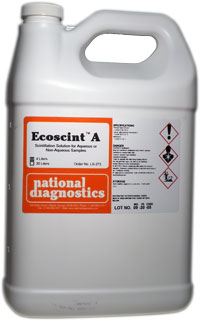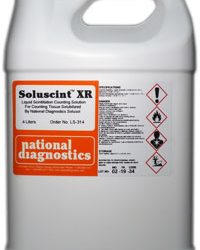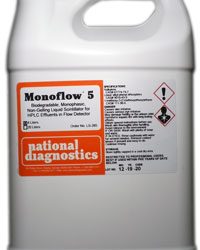Liquid Scintillation
Ecoscint A
$210.00 – $872.00
Catalog Number: LS-273
- The Ideal Universal Scintillation Cocktail
- All-Around Performance
- High Efficiency with High Sample Holding
- Biodegradable, Reduced Toxicity Solvent
- High Flash Point (>150°C)
Description
Catalog Number: LS-273
- The Ideal Universal Scintillation Cocktail
- All-Around Performance
- High Efficiency with High Sample Holding
- Biodegradable, Reduced Toxicity Solvent
- High Flash Point (>150°C)
Ecoscint A displays exceptional sample holding capability while still delivering high efficiency, easily accommodating up to 40% sample while maintaining a single liquid phase. Furthermore, Ecoscint A has exceptional resistance to photoluminescence and chemiluminescence. Ecoscint A is readily biodegradable, with a mean DOC elimination of >70% at 10 days. The high flash point, low odor and low toxicity of Ecoscint A make it perfect for benchtop work, as it is not necessary to use or store under a fume hood.
Ecoscint A maintains its high sample hold capacity for a broad range of solution types, delivering high-efficiency counting for many different types of samples.
Additional information
| Weight | 9 lbs |
|---|---|
| Dimensions | 15 × 9 × 12.25 in |
Safety Overview
Safety Summary (see SDS for complete information before using product):
EMERGENCY OVERVIEW – IMMEDIATE HAZARD
Phenyl Xylyl Ethane (PXE)
MAY BE IRRITATING TO THE SKIN, EYES, AND RESPIRATORY TRACT.
Linear alkyl phenyl ethoxylates
CAUSES EYE IRRITATION. MAY CAUSE RESPIRATORY TRACT IRRITATION.
- Waste Disposal Issues in Scintillation Counting
- The Complete Scintillation Cocktail
- Radioactive Emissions and the Use of Isotopes in Research
- Preparing Tissue Samples for Scintillation Counting
- Preparing Samples in PAGE Gels for LSC
- Mechanism of Liquid Scintillation Counting
- Measurement of Radiation and Isotope Quantitation
- Liquid Scintillation Signal Interpretation
- Liquid Scintillation and Radiation Safety
- HPLC Flow Counting
- Counting Samples on Cellulose-Ester Filters
- Counting Samples from TLC Plates by LSC
- Counting Efficiency and Quenching
- Counting Carbon Dioxide by LSC
- Chemiluminescence and Static Electricity
- Assaying Discrete Samples by Liquid Scintillation Counting




